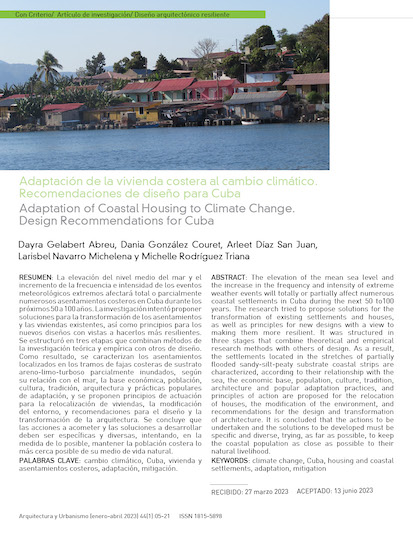Adaptación de la vivienda costera al cambio climático. Recomendaciones de diseño para Cuba
Adaptation of Coastal Housing to Climate Change. Design Recommendations for Cuba
Keywords:
climatechange, Cuba, housing and coastalsettlements, adaptation, mitigationAbstract
The elevation of the mean sea level and the increase in the frequency and intensity of extreme weather events will totally or partially affect numerous coastal settlements in Cuba during the next 50 to 100 years. The research tried to propose solutions for the transformation of existing settlements and houses, as well as principles for new designs with a view to making them more resilient. It was structured in three stages that combine theoretical and empirical research methods with others of design. As a result, the settlements located in the stretches of partially flooded sandy-silt-peaty substrate coastal strips are characterized, according to their relationship with the sea, the economic base, population, culture, tradition, architecture and popular adaptation practices, and principles of action are proposed for the relocation of houses, the modification of the environment, and recommendations for the design and transformation of architecture. It is concluded that the actions to be undertaken and the solutions to be developed must be specific and diverse, trying, as far as possible, to keep the coastal population as close as possible to their natural livelihood.

Downloads
Published
How to Cite
Issue
Section
License
a. The authors retain the copyright and guarantee the magazine the right to be the first publication of the work as well as a Creative Commons Attribution License that allows others to share the work with an acknowledgment of the authorship of the work and the initial publication in this magazine.
b. Authors may separately establish additional agreements for the non-exclusive distribution of the version of the work published in the journal (for example, place it in an institutional repository or publish it in a book), with an acknowledgment of its initial publication in this journal.
c. Authors are allowed and encouraged to disseminate their work electronically (for example, in institutional repositories or on their own website) before and during the submission process, as it can lead to productive exchanges, as well as a more early and major published papers (See The Effect of Open Access, in English).

